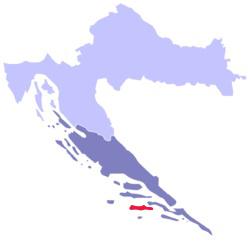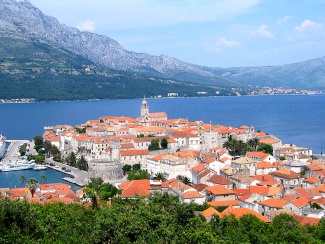Korcula and Italian Wikipedia

Korcula Town
Curzola (in Croatian Korčula) [1] is the largest town of the island of Korčula in Dalmatia. [2][3]
Location (Località)
The town of Korčula is made up of five settlements (naselje):
- Korčula
- Bùgnore (Žrnovo)
- Poponatta (Pupnat)
- Porto Barbieri (Račišće)
- Villa Chiarra (Čara)
History (Storia)
Korčula was a Bishopric[4] from 1300 to 1828.
Italian (Italiani)
Up till 1900s the Italians (Venetians) [5] constituted over half the population of Korčula town (and the nearby village of Petrara-Vrnik). [6] Following the island's annexation by the Kingdom of Yugoslavia their number decreased. After the massacres of Croatians by the communists after World War II caused the flight of the last remaining native Italians in the town.
Italians from Korcula in the nineteenth and twentieth century
(Gli italiani a Curzola nel XIX e nel XX secolo)
At the census of 1910 Italians were 25% of the population of the centre of Korčula and 15% of the nearby village of Petrara (Vrnik). In the rest of the town, as well as in the rest of the island, there were Italians. The majority of Italians were small artisans, especially stone cutters, masons and carpenters.
In the towns of Korčula and Petrara (Vrnik) were people employed in trades such as teaching who were known and appreciated beyond the borders of Dalmatia. A minority, however, was made up of landowners, merchants and retailers. In 1861 political representatives of the Italian language in Korčula were Auditors of the Smerchinich family (Smerkinić, of Slavic origin). In 1867 an Italian of the Smerchinich family was elected to parliament in Vienna. However, Austrian authorities had begun the work of slavitization of the town. The Austrians considered the Croats were more loyal subjects than the Italians.
In 1893, there were protests by the local population. The imperial authorities closed the local Italian school and education was provided solely in Korčula in Croatia however the town of Korčula continued to vote for the Smerchinich family. In 1895, in response to the growing slavitization of the town of Korčula one of the first sites of the National League was founded. The League strove for the preservation of Italian language and culture on site.
In 1909, however, despite the slavitization, all the acts of local authorities in the district of Korčula still had bilingual character. With the collapse of Austria-Hungary following the end of World War I, fierce disputes between Italians and Croatians occurred in Korčula
On November 4, 1918, the Italian navy occupied the city. However, in 1921, Italy gave up and retreated from the island, throwing into turmoil and caused depression in the local Italian population (then about 900 people). The situation was aggravated by the fact that between 1918 and 1920, the Italian occupying authorities had incited and caused part of the Italian anti-Yugoslav conflict. This created animosity among Italians and Croats, who were afraid of the risk of reprisals at the time of the advent of the sovereignty of Yugoslavia, and the risk of an exodus of the Italian population.
In March 1921, that situation occurs and the exodus of Italians from Korčula began. This was accelerated by events and rallies hostile to Italy that were repeated daily fuelled in particular by the brothers Arneri (of Italian origin), former Austrian officials.
In May 1921, more than half of local Italians had left the island. At the end of that year, only 180 Italians who had stayed on the island, gathered around the local school, then closed. In 1923, the number of Italians had been reduced to 46. Many of these remaining Italians, however, had preferred to have Yugoslav citizenship in exchange for not losing their economic activities. Indeed, in 1933 the mixed elementary school had 40 Italian pupils. Korčula also continued to operate the Italian Union, an association chaired by Michele Smerchinich, with 41 members. These people were remaining members of the main Italian families (Benussi, Damianovich, Depolo, Perucich, Radizza, Smerchinich, Vinz, Zanetti).
At the end of World War II, however, there were no Italians left on Korčula.
Towns and municipalities in the region of Dubrovnik - Neretva
Korčula · Metcovich (Metković) · Fort Opus (Opuzen) · Porto Toler (Ploče) · Ragusa (Dubrovnik) Common: Blatta (Blato) · Dubrovačko Primorje · Iagnina (Janjina) · Valley Channels (Konavle) · Norino Tower (Kula Norinska) · Lastovo (Lastovo) · Lombarda (Lumbarda) · Mljet (Mljet) · Pojezerje · Sabbioncello (Orebić ) · Slivno · Smoquizza (Smokvica) · Pond (Stone) · Trpanj (Trpanj) · Vallegrande (Vela Luka) · Zažablje · Župa dubrovačka ·
References
- ^ Editors note: In Croatian the c in Korcula is pronounced ch and is written "č".
- ^ Editors note: ""Korcula." Encyclopædia Britannica. Encyclopædia Britannica Online. Encyclopædia Britannica, 2011. Tue. 8 Mar. 2011." (2011). Retrieved on 2011-03-8.
- Encyclopædia Britannica: "Korčula, Italian Curzola, Greek Corcyra Melaina, island in the Adriatic Sea, on the Dalmatian coast, in Croatia. With an area of 107 square miles (276 square km), it has a hilly interior rising to 1,863 feet (568 m). The Greeks colonized it in the 4th century bc. Korčula was subsequently occupied by the Romans, Goths, Slavs, Byzantines, and Genoese; the kings of Hungary and Croatia"
- ^ Editors note:Encyclopaedia Britannica (publ. 1911):
- "CURZOLA (Serbo-Croatian Korcula or Karkar), an island in the Adriatic Sea, forming part of Dalmatia, Austria; and lying west of the Sabioncello promontory, from which it is divided by a strait less than 2 M. wide. Its length is about 25 m.; its average breadth, 4 m. Curzola (Korcula), the capital and principal port, is a fortified town on the east coast, and occupies a rocky foreland almost surrounded by the sea."
- ^ Editors note: Bishopric or Diocese is an ecclesiastical region run by a bishop in the Roman Catholic, Orthodox Christian, Anglican and some Lutheran churches.
- ^ Editors note: Concerning the Number of Italians/Pro-Italians in Dalmatia in the XIXth Century by Šime Peričić
- "It is true, then a small colony of Italians where in Sibenik, on the island of Korcula, Hvar and Vis, and other places of the province."
- ^ Editors note: Skoji Islands - Korcula Archipelago: "Petrara or Vrnik is the second largest island in Skoji Archipelago. This is populated island, with the village of the same name. Vrnik is the site of the oldest and most famous Korčula quarry. There are only couple of families that presently live in this picturesque village, and some of them let rooms and apartments to tourists."
This article is a work in progress. Sections of the article is transferred from Wikipedia.
|
- Taken from it.wikipedia.org Link
- Additional editing done by Peter Z. 11:26, 8 April 2011 (UTC)
- For the original from Goole Translate link here
Note: Clearly Google Translate is not 100% accurate.
See also (not the orginal)
<sharethis />
